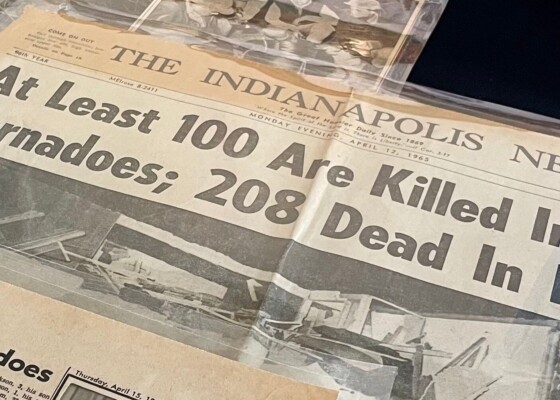Larry Wappel, Wappel Farms: Mint in the air
September 28, 2011For the past two years, Indiana Humanities has explored how we think about, experience and share what we eat through our statewide Food For Thought initiative. Now we are adding…
For the past two years, Indiana Humanities has explored how we think about, experience and share what we eat through our statewide Food For Thought initiative. Now we are adding a capstone to this program by commissioning a book about Indiana food. Award-winning writer David Hoppe and our own communications and program officer, Kristin Hess, are collaborating on this project. Over the course of the next year, they will be traveling throughout the state, interviewing and photographing a lively cross-section of individuals — from James Beard-nominated chefs to blueberry farmers, bison ranchers to activists working to feed the hungry — all of whom are helping to make this such an extraordinary time in the history of Hoosier cuisine. Stay tuned for updates and excerpts from the road as David and Kristin explore Indiana’s food ways.
This post is an example of an interview you might find in the Food For Thought Legacy Book. Enjoy!
******************************************
Drive Highway 421 between San Pierre and North Judson after a rainstorm in July and, if you’re lucky, you’ll smell the aroma of fresh peppermint wafting up from the fields. Larry Wappel is a third generation farmer who has been growing mint and distilling the oil since 1988. Of the 60,000 acres of mint devoted to mint in the United States, about 15,000 acres are found in northwest Indiana. “I like challenges,” says Wappel. “I love my job. I love farming. I like to see if I can grow something different. So I started working on the mint farms one summer for something to do and liked what I saw. I thought I could do this.” Wappel says farmers are also fabricators: He has built much of his own specialized mint farming gear – diggers, planters, and steam distillation equipment, including separators and condensers — in his shop.
Mint was brought into Northwest Indiana in the late ‘20s or early ‘30s by two pretty big farm families because of the organic soils we have. The muck soils are very high in organic; they are fluffy, loose; they’re not a clay or a tight soil. If we try to grow it in tight clay soils or the prairie soils, like you have in central Illinois or down in central or southern Indiana, it will not do so well. The roots have to be able to penetrate the soil.
And mint requires a lot of water. Surface water. It doesn’t have the deep taproot that goes down like corn or other root crops. All the roots are concentrated in the top five or six inches. Our water table here is about three feet down. I dig a hole and I’m going to have water right now, coming in at three feet. This is very good for us because we get the water where it’s needed on mint, and that’s in the top six inches of the soil profile. We’re very successful with either pumping out of ditches for our water or doing very shallow wells and are able to pump on those all the time. There are only a few spots in the nation like this, and one of them happens to be here, in the Kankakee River Basin.
We also have more varying microclimates because of Lake Michigan. That’s why you see the grapes and the apples and cherries. Here we still catch the lake effect – it preserves our roots. Mint’s a perennial, the roots are living organisms for next year’s crop, so we love to see snow and we get a lot more snow here in winter.
I have 1,200 acres of spearmint and peppermint. About 200 acres of native spearmint, which is completely different. It’s the mint family, but it’s the spearmint family, so when we distill that, we have to keep it separate, totally separate. If I saw a spearmint plant in my peppermint field, I’d pull it out and get rid of it. It has its own special uses, and there’s a small need for it, but most mint farmers in Indiana don’t even mess with it. I think the Midwest need is 10 percent spearmint versus 90 percent peppermint.
Most goes back to Wrigley’s and Colgate. It’s a mainstay for toothpaste and mouthwashes, as far as Colgate/Palmolive goes. Then, of course, Wrigley’s is candies and gums. There’s also a small amount that goes to liqueur companies for things like peppermint schnapps.
When Wrigley’s has a gum, let’s say Doublemint Gum, they want Doublemint Gum to be the same from year to year to year. So our oil is going to be very similar each year, but not perfectly similar because we have different weather from year to year. The buyer-broker’s job is to buy oil – say, from the Midwest – and then squeeze in some cheap oil from India or China, and still meet Wrigley’s specs for that year. Just like there’s a recipe for any food, there is a recipe for Wrigley’s for a specific mint oil, and it’s got to be consistent.
We have probably the most desirable oil. If you’re going to use oil for blending purposes, you want ours on the top of the line to blend with. In the United States, we have Midwest oil. The Midwest oil is grown in southern Michigan, northwest Indiana, and in parts of Wisconsin. We’re in the right latitude and longitude for that. Then there’s the Far West oil, which is grown in Washington, Oregon, Idaho. They have a totally different climate and the oils have different chemical make-ups that look completely different from our oil.
When buyers first get a sample of our oil, they’re like wine tasters. They’ll take a little swizzle stick and they’ll dip it in each sample. Then they’ll take it in a little glass and they’ll hold it up to the light to see what color it has, how clear it is. They grade it according to their taste, and the smell, and the color, and then they’ll run it through the Gas Chromatograph and grade it for purity.
The neat thing is this variety of peppermint goes back at least 80 or 90 years in Indiana and, before that, it was brought from Europe and settled in Pennsylvania for awhile. That’s where the Black Mitcham variety we grow actually came from.
There’s little, bitty microscopic oil glands on the bottom sides of the leaves. There’s no oil on the stem, there’s no oil on the top sides of the leaves; it’s all down below. Just walking through it, we’re rupturing those little oil glands. So right after a big storm, if the wind comes through here, it’ll blow the mint and they’ll rub on each other and break the oil glands. Then you’ll have a real strong smell of mint in the air.

